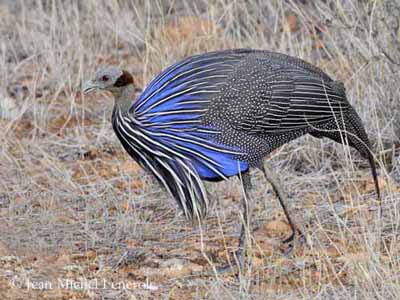
Fr: Pintade vulturine
All : Geierperlhuhn
Esp : Pintada Vulturina
Ital: Faraona vulturina
Nd: Gierparelhoen
Sd: Gampärlhöna
Photographers:
Jean Michel Fenerole
Photos d’Oiseaux du monde
Steve Garvie
RAINBIRDER Photo galleries
Tom Merigan
Tom Merigan’s Photo Galleries
Text by Nicole Bouglouan
Sources:
HANDBOOK OF THE BIRDS OF THE WORLD Vol 2 by Josep del Hoyo-Andrew Elliot-Jordi Sargatal - Lynx Edicions - ISBN: 8487334156
L’ENCYCLOPEDIE MONDIALE DES OISEAUX - Dr Christopher M. Perrins - BORDAS - ISBN: 2040185607
BIRDS OF AFRICA SOUTH OF THE SAHARA by Ian Sinclair and Peter Ryan - Princeton University Press Princeton and Oxford - ISBN: 0691118159
BirdLife International (BirdLife International)
Wikipedia, the free encyclopaedia
Vulturine Guineafowl
Acryllium vulturinum
Galliforme Order – Numididae Family
BIOMETRICS:
Length: 60-72 cm
Weight: 1025-1645 g
DESCRIPTION:
The Vulturine Guineafowl got its name from its appearance. The bare skin of head and neck makes it very similar to vultures. But in spite of this bald head, this guineafowl shows a beautiful plumage.

The adult has dark grey body plumage, heavily but finely spotted white. The tapered tail and the wings show the same pattern, but the secondary flight feathers are edged lilac.
The bright cobalt-blue back and breast are overlaid with elongated, lanceolate, black and white hackles starting from the mid-neck. These narrow feathers “dance” when the bird is moving, giving it an elegant stance.
The blue-cobalt colour of the breast contrasts strongly with the grey and black body plumage. The underwing show dark grey spotted-white coverts, and greyish-white flight feathers.
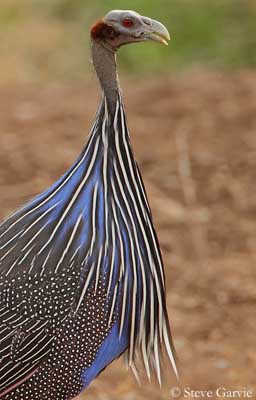
Both sexes are similar in plumage, but the female is smaller than the male.
The juvenile has some streaked down on the head. It has duller greyish-brown plumage, barred and spotted, brown and rufous.
VOICE: SOUNDS BY XENO-CANTO
The Vulturine Guineafowl utters high-pitched, metallic “chink-chink-chink-cheenk-cheek krrrrrrr”.
HABITAT:
The Vulturine Guineafowl frequents the scrubs at lowland forest edges, but also dry and more open areas than other guineafowls. It can be found in arid thorn-scrub, in grassland with trees and bushes and in arid and semi-arid areas.
According to the range, it frequents montane forest in Kenya, and forages in tall riverine Acacia woodland. It is visible up to 1900 metres of elevation.
RANGE:
The Vulturine Guineafowl is sedentary in its range in S Ethiopia, NW and SW Somalia, arid parts of N and E Kenya and NE Tanzania.
BEHAVIOUR:
The Vulturine Guineafowl feeds primarily on plant matter such as seeds, leaves, berries, fruits, roots, bulbs, green buds and shots. But it also catches several large insects, scorpions and spiders, and small molluscs.
This species is mainly terrestrial and forages on the ground by scratching with the feet. However, this guineafowl can climb into bushes and small trees to reach fruits and berries.
These birds do not need to drink often, due to the vegetal diet which provides them sufficient water.
The Vulturine Guineafowl lives in flocks of 20-30 individuals outside the breeding season. They are gregarious birds, feeding and roosting together. They roost at night high in trees and reach the roosts by flying. If they are disturbed or excited, their calls are heard over long distances. During the hottest hours of the day, they rest perched in the thick vegetation.
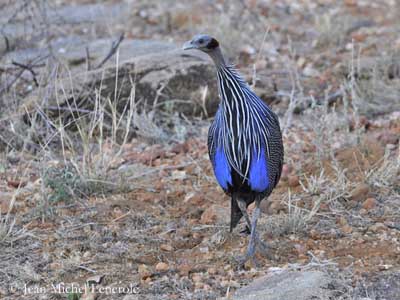
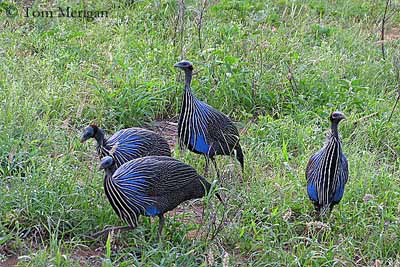
Usually, there is a complex social structure within the group. These birds sometimes associate with other species, as well birds as mammals, for more foraging success. The Vulturine Guineafowl often follows the arboreal monkeys to take the fallen fruits dropped onto the ground.
But when the breeding season approaches, they disperse and can be seen solitary or in pairs. The birds become aggressive and fights occur between rival males. They perpetually chase each other and fight, while the mates communicate both by vocal and visual signals to maintain the pair-bonds. The Vulturine Guineafowl performs ritualized courtship feeding.
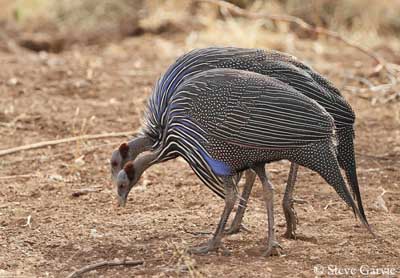
FLIGHT:
The Vulturine Guineafowl, as most Galliformes and other Numididae species, rarely flies and prefers to walk or run if disturbed.
They are highly mobile in spite of the reluctance to fly. They are, however, strong fliers and can fly over a distance of up to 500 metres if necessary.
REPRODUCTION:
Breeding peaks occur in June and December/January.
The Vulturine Guineafowl nests on the ground, in a scrape made by the female. The nest is situated under the cover of dense tussocks of grasses, or protected by rock or bush. It breeds in dry, open areas with some trees and bushes in savannahs or grasslands.
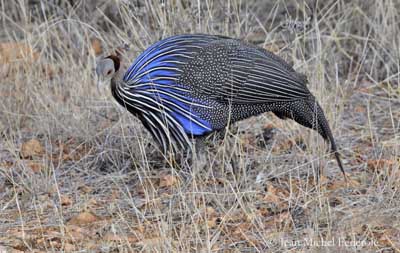
The female lays between 13 and 15 eggs, but two females can lay in the same nest. The eggs are creamy-white or pale brown. The incubation lasts about 28 days. The chicks are precocial and leave the nest almost immediately. They are able to feed themselves but their parents guide and protect them for some time. They are able to fly about 15-20 days after hatching, and can reach the communal roosts in trees.
Both adults defend the chicks if they are threatened. They perform frontal displays with spread wings before to attack. The young birds usually remain 2-3 months within the family group.
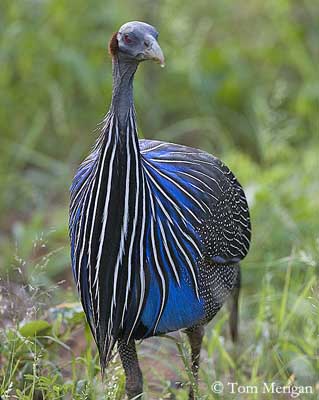
DIET:
The Vulturine Guineafowl feeds mainly on plant matter such as seeds, leaves of grasses, berries and fruits taken in bushes and small trees, and also roots and bulbs reached with the strong bill by digging out the underground food items. It also takes green buds and shoots.
This bird catches large insects, scorpions, spiders and small molluscs by walking along, pecking at the ground and scratching with the feet.
PROTECTION / THREATS / STATUS:
The Vulturine Guineafowl is not currently threatened. It is usually common and abundant, and the populations appear secure. They suffer locally from hunting pressure. They have numerous predators such as raptors, but also monkeys and other mammals which take the eggs and the chicks, and sometimes kill the adults.
But the numbers are stable at this moment.
Female on the foreground. She is smaller.
On the background, the male has longer spurs on the rear of the legs.
Head and upper neck are bare, with pale bluish-grey skin. However, we can see a bright chestnut patch on the nape, made with short, thick down. The lower half of the neck shows on the rear part some short, fine, black and white erected feathers, forming as a light ruff.
The strong bill is horn-coloured, slightly decurved with broad base, very typical of the Galliforme species.
The eyes are deep red. The long legs and the feet are dark grey.